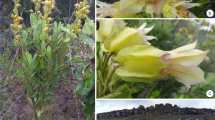Abstract
Leaflets of 65 species ofCaesalpinia s.l. and seven species ofHoffmannseggia were studied in clearings supplemented by resin sections and scanning electron microscopy. Three types of secretory structure occurred among 46 species; in 43 species they were distributed mutually exclusively (external glands: 8 species; internal cavities: 5 species; idioblastic cells: 30 species); three other species each had two types. Species with secretory structures conform mostly to proposed subgenera and informal “groups.” Other unusual features were external glands with internal spaces, thickened walls or conspicuous localized wall thickenings in epidermal cells or mesophyll cells of certain species, and differentially stained epidermal cells surrounding stomata. Prismatic crystals predominate but druse crystals also occur.
Similar content being viewed by others
References
Dellien, F., 1892: Ueber die systematische Bedeutung der anatomischen Charaktere der Caesalpinieen. — Ph.D. Thesis, Friedrich-Alexander-Universität Erlangen, Germany.
Lersten, N. R., 1986: Modified clearing method to show sieve tubes in minor veins of leaves. — Stain Technol.61: 231–234.
—, Carvey, K. A., 1974: Leaf anatomy of ocotillo (Fouquieria splendens; Fouquieriaceae), especially vein endings and associated veinlet elements. — Canad. J. Bot.52: 2017–2021.
—, Curtis, J. D., 1993: Subepidermal idioblasts in leaflets ofCaesalpinia pulcherrima andParkinsonia aculeata (Leguminosae: Caesalpinioideae). — Bull. Torrey Bot. Club120: 319–326.
Polhill, R. M., Vidal, J. E., 1981: Tribe 1.Caesalpinieae. — InPolhill, R. M., Raven, P. H., (Eds): Advances in legume systematics,2, 1, pp. 81–95. — Proc. Int. Legume Conference, Royal Botanic Gardens, Kew, July 24–29, 1978.
Potgieter, M. J., van Wyk, A. E., 1992: Intercellular pectic protuberances in plants: their structure and taxonomic significance. — Bot. Bull. Acad. Sin.33: 295–316.
Solereder, H., 1908: Systematic anatomy of the dicotyledons. — Oxford: Clarendon Press.
Tucker, S. C., 1964: The terminal idioblasts in magnoliaceous leaves. — Amer. J. Bot.51: 1051–1062.
—, Rugenstein, S. R., Derstine, K., 1984: Inflated trichomes in flowers ofBauhinia (Leguminosae: Caesalpinioideae). — Bot. J. Linn. Soc.88: 291–301.
Vogelmann, T. C., Martin, G., 1993: The functional significance of palisade tissue: penetration of directional versus diffuse light. — Pl. Cell Environ.16: 65–72.
Watson, L., 1981: An automated system of generic descriptions forCaesalpinioideae, and its application to classification and key-making. — InPolhill, R. M., Raven, P. H., (Eds): Advances in legume systematics,2, 1, pp. 65–80. — Proc. Int. Legume Conference, Royal Botanic Gardens, Kew, July 24–29, 1978.
Zindler-Frank, E., 1987: Calcium oxalate crystals in legumes. — InStirton, C. H., (Ed.): Advances in legume systematics,2, 3, pp. 279–316. Royal Botanic Gardens, Kew.
Author information
Authors and Affiliations
Rights and permissions
About this article
Cite this article
Lersten, N.R., Curtis, J.D. Leaf anatomy inCaesalpinia andHoffmannseggia (Leguminosae, Caesalpinioideae) with emphasis on secretory structures. Pl Syst Evol 192, 231–255 (1994). https://doi.org/10.1007/BF00986254
Received:
Revised:
Accepted:
Issue Date:
DOI: https://doi.org/10.1007/BF00986254




